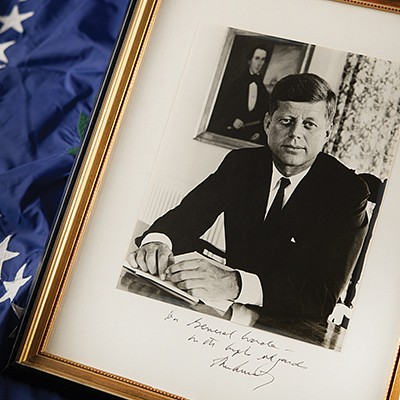Henri Becquerel Handwritten Scientific Document, Listing Famed Physicists, Inventors, and Their Discoveries
Two ways to bid:
- Leave a max absentee bid and the platform will bid on your behalf up to your maximum bid during the live auction.
- Bid live during the auction and your bids will be submitted real-time to the auctioneer.
Bid Increments
| Price | Bid Increment |
|---|---|
| $0 | $5 |
| $50 | $10 |
| $200 | $25 |
| $500 | $50 |
About Auction
May 15, 2024
Boasting nearly 800 lots, RR Auction's May Fine Autographs and Artifacts sale is highlighted by a section honoring the anniversary of President John F. Kennedy's birth—including important signed photographs, a remarkable Kennedy family-signed book, a knife used to slice his inaugural cake, a page from his pioneering Peace Corps legislation, and scarce teletype reports on his assassination. RR Auction support@rrauction.com
- Lot Description
French physicist (1852-1908) whose experiments with uranium salts led to the discovery of spontaneous radioactivity; for this breakthrough he shared the 1903 Nobel Prize for Physics with Marie and Pierre Curie. Unsigned handwritten document in French by Henri Becquerel, two pages on two adjoining sheets, 7.75 x 11.75, headed: "Historique des machines." The list concerns direct current dynamo-electric machines, and was most likely prepared as an aide-memoire for one of his first physics courses at the Ecole Polytechnique in Paris. Becquerel has listed the names of various famous inventors alongside the dates of their discoveries and summary notes, several with explanatory scientific drawings alongside, including Faraday ("1831 Anneaux de fer......d'une bobine [Iron rings......a coil]"), Pixii ("En 1832......aimants dans un disque bois mobile devant des bobines [magnets in a moveable wooden disk in front of coils]"), Ritchie ("bobines mobiles [moving coils"), Clarke, Nollet, Siemens, Wilde ("aimants et electro aimants [magnets and electro magnets]"), Ladd, Pacinotti, Gramme, Varley, Wheatstone, Alteneck, and Edison. To the foot of the first page appear various scientific equations and drawings in pencil, most crossed through. In fine condition. A good scientific manuscript featuring the names of many inventors and physicists who inspired and influenced Becquerel.
Those referenced in the document include:
Michael Faraday (1791-1867) English scientist who contributed to the study of electromagnetism and electrochemistry.
Hippolyte Pixii (1808-1835) French instrument maker who built an early form of alternating current electrical generator based on the principle of electromagnetic induction discovered by Faraday.
Edward Samuel Ritchie (1814-1895) American inventor and physicist who made important contributions to science and navigation.
Hyde Clarke (1815-1895) English engineer, philologist and author.
Floris Nollet (1794-1853) Belgian physicist, engineer and inventor who designed plans for large-scale generators.
Werner von Siemens (1816-1892) German electrical engineer, inventor and industrialist.
Henry Wilde (1833-1919) English electrical engineer who invented the dynamo-electric machine.
William Ladd (1815-1885) English manufacturer of microscopes and other scientific instruments including the Dynamo-Magneto-Electric machine (1867).
Antonio Pacinotti (1841-1912) Italian physicist, best known for inventing an improved form of direct-current electrical generator (1860).
Zenobe Gramme (1826-1901) Belgian electrical engineer, inventor of the Gramme machine, a type of direct current dynamo capable of generating smoother and much higher voltages than the dynamos known to that point (1871).
C. F. Varley (1828-1883) English engineer particularly associated with the development of the electric telegraph and the transatlantic telegraph cable.
Charles Wheatstone (1802-1875) English scientist and inventor who made many scientific breakthroughs during the Victorian era.
Friedrich von Hefner-Alteneck (1845-1904) German electrical engineer, one of the closest aides of Werner von Siemens.
Thomas Edison (1847-1931) American inventor of the electric light bulb among many other items. - Shipping Info
-
Bidder is liable for shipping and handling and providing accurate information as to shipping or delivery locations and arranging for such. RR Auction is unable to combine purchases from other auctions or affiliates into one package for shipping purposes. Lots won will be shipped in a commercially reasonable time after payment in good funds for the merchandise and the shipping fees are received or credit extended, except when third-party shipment occurs. Bidder agrees that service and handling charges related to shipping items which are not pre-paid may be charged to a credit card on file with RR Auction. Successful international Bidders shall provide written shipping instructions, including specified Customs declarations, to RR Auction for any lots to be delivered outside of the United States. NOTE: Declaration value shall be the item’(s) hammer price and RR Auction shall use the correct harmonized code for the lot. Domestic Bidders on lots designated for third-party shipment must designate the common carrier, accept risk of loss, and prepay shipping costs.
-
- Buyer's Premium



 EUR
EUR CAD
CAD AUD
AUD GBP
GBP MXN
MXN HKD
HKD CNY
CNY MYR
MYR SEK
SEK SGD
SGD CHF
CHF THB
THB




